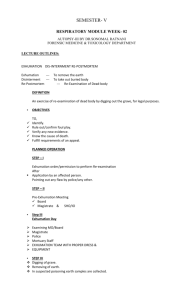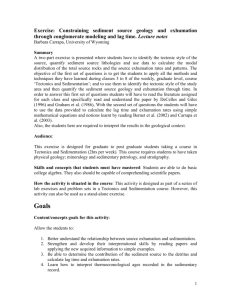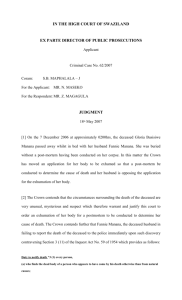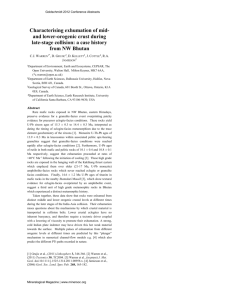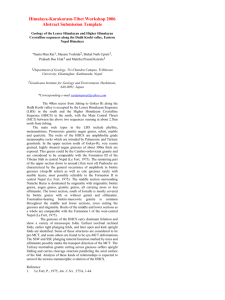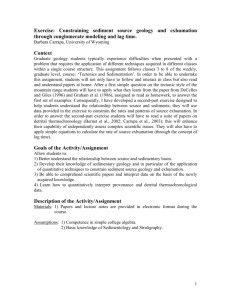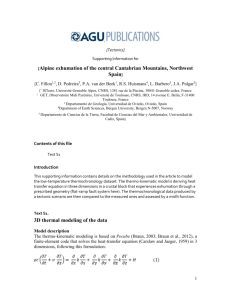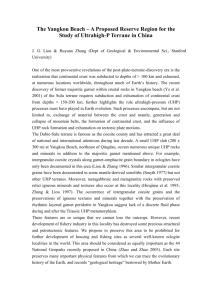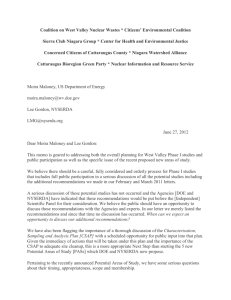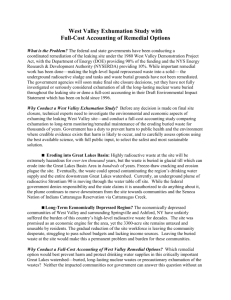Crustal-scale boudinage and migmatization of gneiss during
advertisement
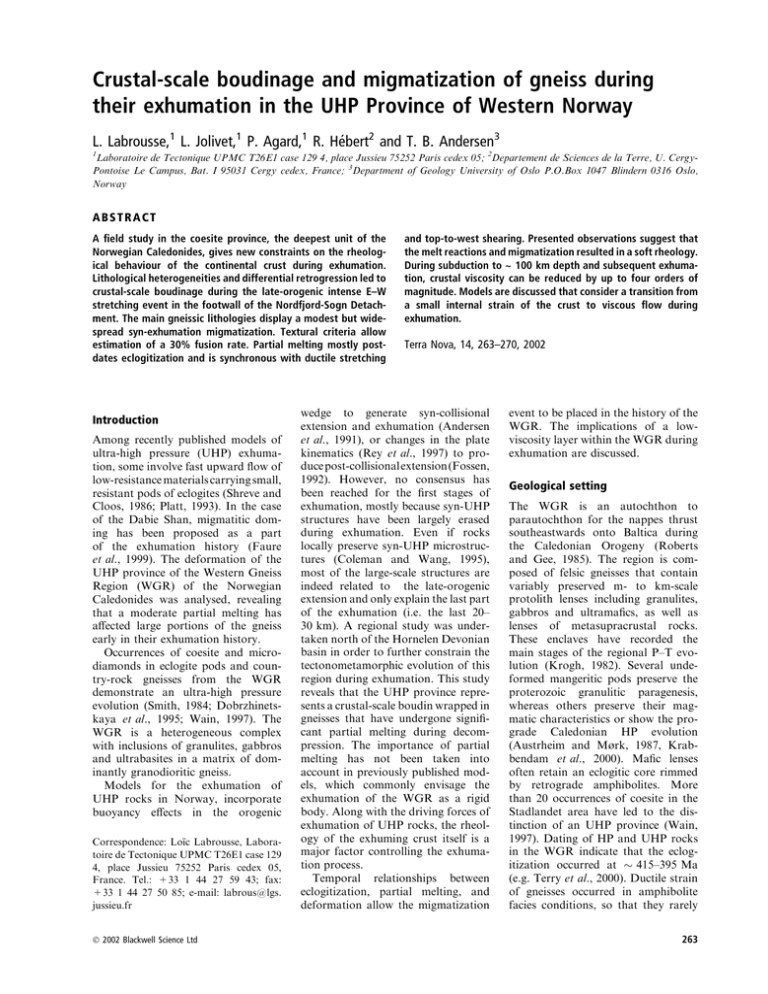
Crustal-scale boudinage and migmatization of gneiss during their exhumation in the UHP Province of Western Norway L. Labrousse,1 L. Jolivet,1 P. Agard,1 R. Hébert2 and T. B. Andersen3 1 Laboratoire de Tectonique UPMC T26E1 case 129 4, place Jussieu 75252 Paris cedex 05; 2Departement de Sciences de la Terre, U. CergyPontoise Le Campus, Bat. I 95031 Cergy cedex, France; 3Department of Geology University of Oslo P.O.Box 1047 Blindern 0316 Oslo, Norway ABSTRACT A field study in the coesite province, the deepest unit of the Norwegian Caledonides, gives new constraints on the rheological behaviour of the continental crust during exhumation. Lithological heterogeneities and differential retrogression led to crustal-scale boudinage during the late-orogenic intense E–W stretching event in the footwall of the Nordfjord-Sogn Detachment. The main gneissic lithologies display a modest but widespread syn-exhumation migmatization. Textural criteria allow estimation of a 30% fusion rate. Partial melting mostly postdates eclogitization and is synchronous with ductile stretching Introduction Among recently published models of ultra-high pressure (UHP) exhumation, some involve fast upward flow of low-resistance materials carrying small, resistant pods of eclogites (Shreve and Cloos, 1986; Platt, 1993). In the case of the Dabie Shan, migmatitic doming has been proposed as a part of the exhumation history (Faure et al., 1999). The deformation of the UHP province of the Western Gneiss Region (WGR) of the Norwegian Caledonides was analysed, revealing that a moderate partial melting has affected large portions of the gneiss early in their exhumation history. Occurrences of coesite and microdiamonds in eclogite pods and country-rock gneisses from the WGR demonstrate an ultra-high pressure evolution (Smith, 1984; Dobrzhinetskaya et al., 1995; Wain, 1997). The WGR is a heterogeneous complex with inclusions of granulites, gabbros and ultrabasites in a matrix of dominantly granodioritic gneiss. Models for the exhumation of UHP rocks in Norway, incorporate buoyancy effects in the orogenic Correspondence: Loı̈c Labrousse, Laboratoire de Tectonique UPMC T26E1 case 129 4, place Jussieu 75252 Paris cedex 05, France. Tel.: +33 1 44 27 59 43; fax: +33 1 44 27 50 85; e-mail: labrous@lgs. jussieu.fr 2002 Blackwell Science Ltd and top-to-west shearing. Presented observations suggest that the melt reactions and migmatization resulted in a soft rheology. During subduction to ~ 100 km depth and subsequent exhumation, crustal viscosity can be reduced by up to four orders of magnitude. Models are discussed that consider a transition from a small internal strain of the crust to viscous flow during exhumation. Terra Nova, 14, 263–270, 2002 wedge to generate syn-collisional extension and exhumation (Andersen et al., 1991), or changes in the plate kinematics (Rey et al., 1997) to producepost-collisionalextension(Fossen, 1992). However, no consensus has been reached for the first stages of exhumation, mostly because syn-UHP structures have been largely erased during exhumation. Even if rocks locally preserve syn-UHP microstructures (Coleman and Wang, 1995), most of the large-scale structures are indeed related to the late-orogenic extension and only explain the last part of the exhumation (i.e. the last 20– 30 km). A regional study was undertaken north of the Hornelen Devonian basin in order to further constrain the tectonometamorphic evolution of this region during exhumation. This study reveals that the UHP province represents a crustal-scale boudin wrapped in gneisses that have undergone significant partial melting during decompression. The importance of partial melting has not been taken into account in previously published models, which commonly envisage the exhumation of the WGR as a rigid body. Along with the driving forces of exhumation of UHP rocks, the rheology of the exhuming crust itself is a major factor controlling the exhumation process. Temporal relationships between eclogitization, partial melting, and deformation allow the migmatization event to be placed in the history of the WGR. The implications of a lowviscosity layer within the WGR during exhumation are discussed. Geological setting The WGR is an autochthon to parautochthon for the nappes thrust southeastwards onto Baltica during the Caledonian Orogeny (Roberts and Gee, 1985). The region is composed of felsic gneisses that contain variably preserved m- to km-scale protolith lenses including granulites, gabbros and ultramafics, as well as lenses of metasupracrustal rocks. These enclaves have recorded the main stages of the regional P–T evolution (Krogh, 1982). Several undeformed mangeritic pods preserve the proterozoic granulitic paragenesis, whereas others preserve their magmatic characteristics or show the prograde Caledonian HP evolution (Austrheim and Mørk, 1987, Krabbendam et al., 2000). Mafic lenses often retain an eclogitic core rimmed by retrograde amphibolites. More than 20 occurrences of coesite in the Stadlandet area have led to the distinction of an UHP province (Wain, 1997). Dating of HP and UHP rocks in the WGR indicate that the eclogitization occurred at 415–395 Ma (e.g. Terry et al., 2000). Ductile strain of gneisses occurred in amphibolite facies conditions, so that they rarely 263 Fig. 1 Tectonic map of the Nordfjord region. Lithologies modified from NGU maps (Kildal, 1970; Lutro and Tveten, 1998; Lutro et al., 1998; Tveten et al., 1998), structural data compiled from this study and literature (Bryhni, 1966; Krabbendam and Wain, 1997). Coesite occurrences from Wain (1997) and Smith (1984). ............................................................................................................................................................. Boudinage and migmatization of gneiss during exhumation • L. Labrousse et al. 264 Terra Nova, Vol 14, No. 4, 263–270 2002 Blackwell Science Ltd Terra Nova, Vol 14, No. 4, 263–270 L. Labrousse et al. • Boudinage and migmatization of gneiss during exhumation ............................................................................................................................................................. preserve HP-assemblages (Krogh, 1977). Ductile structures observed in the WGR can be related to the late Caledonian E–W extension event (Andersen, 1998; Fossen, 2000). E–W stretching and top-to-the-west shearing along the NSDZ is described below. The NSDZ and the underlying gneisses are folded around E–Wtrending axes. Osmundsen and Andersen (2001) showed that this folding is contemporaneous with Devonian sedimentation and E–W stretching. The present study aims to: (i) establish the large-scale structural geometry and position of the UHP-rocks with respect to the lower-grade gneisses in the mapped area; (ii) study the distribution of shear criteria during exhumation; and (iii) constrain the P–T–t evolution. Regional field study The NSDZ is almost vertical along the northern limb of the Hornelen syn- form. The map (Fig. 1) thus shows a vertical section of the crust immediately north of the Hornelen basin. The regional structural characteristics from south to north (i.e. from top to base) are: (i) intensely sheared and retrograded gneisses immediately below the detachment (profile A and B, Fig. 2); (ii) gneisses characterized by partial melting; and (iii) a core containing large-scale boudins of preserved protoliths (profile E, Fig. 2). The stretching lineation in gneisses, pressure shadows around feldspar augen, boudinage of competent layers in the gneiss, elongated mafic lenses in the E–W direction testify to regional E–W stretching at any scale. The pattern of foliation trajectories allows the recognition of structures at the map scale (Fig. 1 and Fig. 2). North of the NSDZ, steep foliations draw a km-scale dextral shear-band taken to be the ductile expression of the NSD (Krabbendam and Wain, 1997). The Stadtlandet–Vågsøy area, with km-scale pods of gabbro, granulite and peridotite, shows irregular foliations with a major E–W axis of folding. Gneisses in the Vanylven– Volda area, situated structurally above the Stadlandet gneiss (profile D, Fig. 2), show intensely folded foliations along the E–W axis, contemporaneous with E–W stretching corroborating the constrictional nature of deformation. Locally, augen gneisses show L-tectonite structures as a result of this constriction (Krabbendam and Dewey, 1998). Shear criteria are mostly dextral in the vertically foliated parts and top-to-the-west in shallow-dipping domains. The attitude of foliation suggests an asymmetrical shape of the granulitic boudins (profile E, Fig. 2), compatible with the top-to-the-west sense of shear. This shear is concordant with the deformation along the NSDZ. In the eastern part of the region around Hornindalsvatn, a zone dominated by sinistral shearing is observed (Fig. 1). Fig. 2 Cross-sections across the Nordfjord region. A, B: N–S profiles showing intense folding parallel to stretching direction and km-scale constriction. C, D, E: E–W profiles showing the tectonic superposition of Volda, Vanylven and Stadlandet peninsulas, and the assymmetrical shape of kilometrical granulite body of Vågsøy. F: detailed profile of granulite bodies, with structural relationships to other peninsulas, showing general vergence to the West. Scale bar is 10 km long. Topography is not exaggerated. 2002 Blackwell Science Ltd 265 Boudinage and migmatization of gneiss during exhumation • L. Labrousse et al. Terra Nova, Vol 14, No. 4, 263–270 ............................................................................................................................................................. Fig. 3 Unscaled schematic cross-section showing the different areas and structural relations on a restored vertical profile. The core of the crustal boudin contains granulites and eclogites (black pods), Stadlandet, Vanylven and Volda are partly migmatized rims sheared to the west with amphibolitized eclogites. The Hornindal shear band is the symetrical limit of the boudin. On top, the ductile shear band associated to the NSD crosscuts these structures to the west. The rocks in the Nordfjord area thus appear as a km-scale stretched mass of gneisses bordered on its southwestern side by a dextral shear-band associated with the NSDZ, and on its southeastern side by the Hornindal sinistral shear-band. On restoring the NSDZ to a horizontal position, central parts of the area appear as a corecomplex bounded by a major topto-the-west and a top-to-the-east shear zone (Fig. 3). The internal parts of this core preserve both gabbros and ultramafics, as well as granulite boudins and coesite-bearing eclogites. The westward sheared and folded gneisses of the Volda–Vanylven area represent the roof for this crustal-scale boudin. Post-eclogite partial melting In the Vanylven and Volda regions, the mafic lenses are surrounded by gneisses with evidence of partial melting (Fig. 4h); most of them are indeed layered metatexites with 50–90% of mesosome. Gneisses show segregations of quartzo-feldspathic leucosomes and melanosomes constituted by biotite and amphibole. Melts have been collected in veins, orientated either parallel to the foliation, or perpendicular to the direction of extension. Where mafic lenses form trains of boudins, liquids are collected in each boudin neck. Contacts between metabasic lenses and the gneisses are often diffuse with crystallization of large amphiboles in the gneisses and in the margins of the lenses (Fig. 4g). Quartz veins, fed by the surrounding gneisses, can also cross-cut the metabasic lenses. The migmatization event thus postdates eclogitization and seems synchronous with the retrogression into amphibolite. 266 Disordered rafts of mesosome contained in nebulites give evidence of postdeformational melting (Fig. 4a). Other outcrops show stretching and boudinage of melanosomes, and congregation of leucosomes into a net of veins. Gneisses show concentrations of small veins parallel to the axial planes of folds (Y–Z plane; Fig. 4b,c), locally delineating an axial plane foliation when connected. Lastly, gneisses show layers of melanosomes and leucosomes that were stretched and sheared at a later stage, indicating that the migmatization commenced early in the exhumation-related deformation history. The syn-migmatitic layering observed allows estimation of a fusion rate of 30% (Vanderhaeghe, 2001). Chronological relationships observed at the outcrop scale can be interpreted, at the regional scale, as an indication of the synchronicity of partial melting and stretching of gneiss. Nevertheless, only minor amounts of fusion products are observed. Moreover, no large-scale connections apparently allowed the melts to be collected into plutons. Pegmatoid dykes and sills are uncommon; when observed, they are of decimetric to metric size only. Furthermore, no major Caledonian anatectic granite has been described in the WGR. Description of migmatites in the Nordfjord area is recurrent in the literature. Bryhni (1966) mentioned migmatites and pegmatites both early and late with regard to gneissic layering, but eventually considered these migmatites as ÔinsignificantÕ. Krabbendam and Wain (1997) locally describe stromatitic, layered gneisses and undeformed pegmatites in the Stadlandet peninsula. The present field observations lead us to point out that (i) moderate partial melting is widespread at the regional scale and (ii) it mostly post-dates eclogitization. Field evidence shows that not only stretching and migmatization, but also E–W folding and migmatization are contemporaneous. As E–W folding is contemporaneous with Devonian sedimentation (Osmundsen and Andersen, 2001), partial melting thus cannot be younger than 370 Ma. Partial melting is thus part of the exhumation history, not a late feature. Andersen et al. (1991, 1994) show a continuum of E–W extension in Sunnfjord, from the peak pressure to the late greenschist shearing. The decompression path for the Nordfjord area (Fig. 5) stands between H2O-fluxed melting curves (Huang and Wyllie, 1981; Stern and Wyllie, 1981; Schmidt, 1993) and dehydration melting curves for crustal rocks Fig. 4 Photographs of migmatized gneiss. (a) Rafts of palaeosome in a pegmatoid neosome. Diffuse borders testify to the collection of fluids from the leucocratic layers of the migmatitic gneiss. (b) Veins parallel and perpendicular to foliation draw a net of percolation for the liquids between the boudins of palaeosome. (c) Pegmatic veins in axial pane of anisopach folds. (d,e) Truncated layers showing collection of pegmatic fluids in the internecks of boudins during E–W stretching. (f,g) Truncated mafic layers showing amphibolitized rims surrounded by pegmatitic neosome. (h) Metre-scale boudins scattered in migmatitic gneiss. White bars are 10 cm long. 2002 Blackwell Science Ltd L. Labrousse et al. • Boudinage and migmatization of gneiss during exhumation Terra Nova, Vol 14, No. 4, 263–270 ............................................................................................................................................................. N S a N b W S W E e SE 2002 Blackwell Science Ltd N c E d f S NW SE g NW S N h 267 Boudinage and migmatization of gneiss during exhumation • L. Labrousse et al. Terra Nova, Vol 14, No. 4, 263–270 ............................................................................................................................................................. Fig. 5 Composite P–T path for the Nordfjord area (Labrousse, 2001). Estimates and error bars have been computed with AX 2000 and THERMOCALC 2.7 software (Holland and Powell, 1998; Powell and Holland, 2001) for eclogitic assemblages (Garnet, omphacite, phengite, quartz ⁄ coesite ± kyanite, talc, amphibole), amphibolitic gneisses (Garnet, biotite, muscovite, plagioclase, quartz ± epidote, chlorite, kyanite ⁄ sillimanite), green schist gneisses (Chlorite, biotite, muscovite, plagioclase, quartz). Estimates for amphibolitic symplectites in retrogressed eclogites were performed using the amphibole–plagioclase thermometer Hb–Plag (Holland and Blundy, 1994) and a clinopyroxene–plagioclase barometer (Perchuk, 1992). All minerals were analysed by EMPA. Solidus curves are (1) for a wet biotite granite (Stern and Wyllie, 1981), (2) for a wet muscovite granite (Huang and Wyllie, 1981), (3) for a wet tonalite (Schmidt, 1993). (4) and (5) are dehydration melting curves of muscovite and biotite for a muscovite granite and a metapelite, respectively. from 2.7 to 0.9 GPa. This suggests that (i) low H2O contents were representative of prograde to climax conditions, (ii) water-rich fluids influx occurred during exhumation (Patino Douce et al., 1990; Schmidt, 1993), and (iii) stretching, partial melting and exhumation were contemporaneous in the Nordfjord. Discussion The gneisses of the Nordfjord thus form a crustal-scale boudin, compris268 ing preserved Proterozoic protoliths and UHP eclogites in its core and sheared amphibolite facies at its margins. The pervasive partial melting is an important feature of this metamorphic core complex. The NSDZ and the associated dextral megashear-band rework previous structures into sheared mylonites. A 10 dipping detachment would need 560 km of lateral motion to be responsible of 100 km of exhumation. In the WGR, rotation of the detachment zone is unlikely (Krabbendam and Wain, 1997), as it would mean that the hanging wall of the NSDZ had to be 560 km eastward of its present position, whereas the present front of the chain is only 450 km east of the Nordfjord. It seems more appropriate to limit the role of the NSDZ only to the later stage of exhumation (Andersen and Jamtveit, 1990). Recently, Wain et al. (2000) argued for stacking of different parts of the WGR characterized by UHP and HP, respectively. Similarly, Terry et al. (2001) have suggested that UHP crustal rocks in the Møre area were exhumed to HP conditions by thrust stacking and then extension and erosion. Other models consider the whole lithosphere. Chemenda et al. (1995) considered a two-layer continental crust with a viscosity contrast of 10–100. Analogue modelling of subduction of such a crust leads to the individualization of a slice of upper crust exhumed by buoyancy forces during convergence. The exhumation of such a rigid portion of crust was proposed by Andersen et al. (1991) for the WGR with a different mechanism. In their model, Andersen et al. (1991, 1994) attributed the rapid eduction of the WGR to buoyancy and horizontal stretching triggered by uncoupling of the mantle lithosphere. Dewey et al. (1993) argued that lithospheric delamination triggered exhumation of buried crust, subsequent surface uplift and collapse. Those models consider a continental lithosphere with fixed viscosities; the subducted and exhumed portion of crust remains rigid. According to Andersen et al. (1991), the rapid uncoupling of the lithospheric mantle allows for a short residence time of crustal material exhumed without thermal equilibration, and therefore keeping a high viscosity. Arguments in favour of this idea come from a model of anatexis in a thickened crust by England and Thomson (1986), where 20 Myr is necessary for the extraction of granitic liquids from gneisses after their burial. The pervasive production of melts described here, argues for a significant change of viscosity of subducted continental crust. A model of partial melting in a thickened crust gives short reaction times (Patino Douce et al., 1990) by distinguishing migmatization and anatexis. All studied scenarios lead to migmatization, which 2002 Blackwell Science Ltd L. Labrousse et al. • Boudinage and migmatization of gneiss during exhumation Terra Nova, Vol 14, No. 4, 263–270 ............................................................................................................................................................. may occur only 4 Myr after crustal thickening. Other studies point out the role of partial melting in exhumation, one of the models for the exhumation of Dabie Shan UHP rocks integrates the migmatization of the adjacent migmatitic dome to the North (Faure et al., 1999). The crustal behaviour inferred from field study in the Shuswap dome by Vanderhaeghe (2000) takes migmatization into account. Thermal reequilibration generates a partly molten lower crust, responsible for the collapse of the thickened crust. Even if extrapolation of laboratory results for rheologies of partially molten rocks to natural phenomena is not possible in a quantitative way (Stökhert and Renner, 1998), one can infer changes of viscosity for migmatites. Local stress enhancement resulting from replacement of grains with liquid, and enhanced kinetics of diffusion owing to short circuit in the melt (Kohlstedt et al. 2000) must lower rock viscosity. For water-saturated olivine–basalt systems, a fusion rate of 30% led to a viscosity divided by 104 (Mei and Kohlstedt, 1999). Experiments on granitic rocks (Rutter and Neumann, 1995) showed that bulk ductility of partially molten granite is sensitive to fusion rate. A fusion rate of 30% leads to a decrease of effective viscosity of four orders of magnitude (Vanderhaeghe, 2001). The migmatites might then have played the role of muddy serpentines or marbles in corner flow models (Shreve and Cloos, 1986) and allow exhumation of dense crustal material. Burov et al. (2001) proposed a fully coupled thermomechanical model to test scenarios of HP rocks exhumation. In all cases high rates of exhumation are observed in the subducting channel. Exhumation is the result both of the shear flow resulting from the overriding plate and of the buoyancy of the crustal material which was heated at depth where it acquired a low viscosity. The exhumation of the WGR might be ruled by such a behaviour. It is certainly not yet possible to conclude that migmatization occurred in the very first stages of exhumation and other mechanisms were probably at work in the deep parts of the subduction channel. After stacking of crustal slices, migmatization of continental material would soften the crust enough to allow upward flow in the 2002 Blackwell Science Ltd subduction channel during convergence. Influx of H2O-rich fluids is necessary to allow this melting at relatively low temperature (600– 650 C). Upper crustal detachements would then overprint these structures with top-to-the-west mylonitization in the last stages of exhumation. Acknowledgments We would like to thank the INSU programme ÔIntérieur de la TerreÕ for financial support. Constructive reviews from A. Chemenda and an anonymous reviewer greatly improved the manuscript. References Andersen, T.B., 1998. Extensional tectonics in the Caledonides of southern Norway, an overview. Tectonophysics, 285, 333–351. Andersen, T.B., Jamtveit, B., Dewey, J.F. and Swensson, E., 1991. Subduction and eduction of continental crust: major mechanisms during continent-continent collision ans orogenic extensional collapse, a model besed on the south Nrwegian Caledonides. Terra Nova, 3, 303–310. Bryhni, I., 1966. Reconnaissance studies of gneisses, ultrabasites, eclogites and anorthosites in outer Nordfjord, western Norway. Norges Geol. Unders., 241, 68. Coleman, R.G. and Wang, X., 1995. Overview of the Geology and tectonics of UHPM. In: Ultrahigh Pressure Metamorphism (R.G. Coleman and X. Wang, eds), pp. 1–32. Cambridge University Press, Cambridge. Dobrzhinetskaya, L.F., Eide, E.A., Larsen, R.B. et al., 1995. Microdiamond in highgrade metamorphic rocks of the Western Gneiss Region, Norway. Geology, 23, 597–600. Faure, M., Lin, W., Shu, L., Sun, Y. and Schärer, U., 1999. Tectonics of the Dabieshan (eastern China) and possible exhumation mechanism of ultra highpressure rocks. Terra Nova, 11, 251–258. Fossen, H., 1992. The role of extensional tectonics in the Caledonides of south Norway. J. Struct. Geol., 14, 1033–1046. Fossen, H., 2000. Extensional tectonics in the Caledonides: Synorogenic or postorogenic? Tectonics, 19, 213–224. Holland, T.J.B. and Blundy, J.D., 1994. Non–ideal interactions in calcic amphiboles and their bearing on amphiboles and their bearing on amphibole plagioclase thermometry. Contr. Miner. Petrol., 116, 433–447. Holland, T.J.B. and Powell, R., 1998. An internally-consistent thermodynamic data set for phases of petrological interest. J. Metamorph. Geol., 16, 309–343. Huang, W.L. and Wyllie, P.J., 1981. Phase relations of S-type granite with H2O to 35 kbar: Muscovite granite from Harney Peak, South Dakota. J. Geophys. Res., 86, 6115–6132. Kildal, E.S., 1970. Geologisk kart over Noreg Måløy. Norges geologiske undersøking. Kohlstedt, D.L., Bai, Q., Wang, Z.C. and Mei, S., 2000. Rheology of partially molten rocks. In: Physics and Chemistry of Partially Molten Rocks (N. Bagdassarov et al., eds). Kluwer, Dordrecht. Krabbendam, M. and Dewey, J.F., 1998. Exhumation of UHP rocks by transtension in the Western Gneiss Region, Scandinavian Caledonides. In: Continental Transpressional and Transtensional Tectonics (R.E. Holdsworth et al., eds). Spec. Publ. Geol. Soc. London, 135, 159–181. Krabbendam, M. and Wain, A., 1997. Late-Caledonian structures, differential retrogression and structural position of (ultra) high-pressure rocks in the Nordfjord-Stadlandet area, Western Gneiss Region. Norges Geol. Unders. Bull., 432, 127–139. Krogh, E.J., 1977. Evidence of Precambrian continent-continent collision in Western Norway. Nature, 267, 17–20. Krogh, E.J., 1982. Metamorphic evolution of Norwegian country-rock eclogites, as deduced from mineral inclusions and compositional zoning of garnets. Lithos, 15, 305–321. Labrousse, L., 2001. L’exhumation desroches me´tamorphiques de tre`s haute pression: le cas des Cale´donides de Norvège. Unpubl. doctoral thesis, Université Pierre & Marie Curie, Paris. Le Breton, N. and Thompson, A., 1988. Fluid-absent (dehydration) melting of biotite in metapelites in the early stages of crustal anatexis. Contr. Miner. Petrol., 99, 226–237. Lutro, O. and Tveten, E., 1998. Geologisk kart over Noreg Årdal. Norges geologiske undersøking. Lutro, O., Thorsnes, T. and Tveten, E., 1998. Geologisk kart over Noreg Ulsteinvik. Norges geologiske undersøking. Mei, S. and Kohlstedt, D., 1999. Influence of water on plastic deformation of olivine-basalt aggregates.. Osmundsen, P.T. and Andersen, T.B., 2001. The middle Devonian basins of western Norway: sedimentary response to large-scale transtensional tectonics? Tectonophysics, 332, 51–68. Patino Douce, A.E., Humphreys, E.D. and Johnston, A.D., 1990. Anatexis and metamorphism in tectonically thickened continental crust exemplified by the Sevier hinterland, western North 269 Boudinage and migmatization of gneiss during exhumation • L. Labrousse et al. Terra Nova, Vol 14, No. 4, 263–270 ............................................................................................................................................................. America. Earth Planet. Sci. Lett., 97, 290–315. Perchuk, A.L., 1992. Novyy variant omfatsit-al’bit-kvartsevogo geobarometra a uchetom strukturnykh sostoyaniy omfatsita i al’bita. Dokl. Ross. Akad. Nauk, 324, 1286–1289. Platt, J.P., 1993. Exhumation of highpressure rocks: a review of concepts and processes. Terra Nova, 5, 119–133. Powell, R. and Holland, T.J.B., 2001. THERMOCALC Workshop 2001: Calculating Metamorphic Phase Equilibria, Course Notes (on CD-ROM). Rey, P., Burg, J.-P. and Casey, M., 1997. The Scandinavian Caledonides and their relationship to the Variscan belt. In: Orogeny Through Time (J.-P. Burg, and M. Ford, eds). Spec. Publ. Geol. Soc. London, . Roberts, D. and Gee, D.G., 1985. An introduction to the structure of the Scandinavian Caledonides. In: The Caledonide Orogen: Scandinavia and Related 270 Areas (D. G. Gee and B. A. Sturt, eds), Vol. 1, pp. 55–68. Wiley, Chichester. Rutter, E.H. and Neumann, D.H.K., 1995. Experimental deformation of partially molten Westerly granite under fluidabsent conditions, with implications for the extraction of granitic magmas. J. Geophys. Res., 100, 15,697–15,715. Schmidt, M.W., 1993. Phase relations and compositions in tonalite as a function of pressure: an experimental study at 650C. Am. J. Sci., 293, 1011–1060. Shreve, R.L. and Cloos, M., 1986. Dynamics of sediment subduction, melange formation, and prism accretion. J. Geophys. Res., 91, 10,229–10,245. Smith, D.C., 1984. Coesite in clinopyroxene in the Caledonides and its implications for geodynamics. Nature, 310, 641–644. Stern, C.R. and Wyllie, P.J., 1981. Phase relationships of I-type granite with H2O to 35 kilobars: the Dinkey Lajes biotite-granite from the Sierra Nevada batholith. J. Geophys. Res., 86, 10,412– 10,422. Stökhert, B. and Renner, J., 1998. Rheology of crustal rocks at ultrahigh pressure. In: When Continents Collide: Geodynamics and Geochemistry of Ultrahigh-Pressure Rocks (B.R. Hacker and J. G. Liou, eds), pp. 57–96. Kluwer, Dordrecht. Tveten, E., Lutro, O. and Thorsnes, T., 1998. Geologisk kart over Noreg Ulsteinvik. Norges geologiske undersøking. Vanderhaeghe, O., 2001. Melt segregation, pervasive melt migration and magma mobility in the continental crust: the structural record from pores to orogens. Phys. Chem. Earth, 26, 213–223. Wain, A., 1997. New evidence for coesite in eclogite and gneisses: defining an ultrahigh pressure province in the Western Gneiss region of Norway. Geology, 25, 927–930. Received 5 July 2001; revised version accepted 26 March 2002 2002 Blackwell Science Ltd
